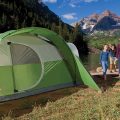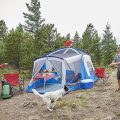Last Updated on August 3, 2022 by Dean Anderson
Most of us have heard this familiar camping story: a great trip is hampered by an unexpected rainfall. Maybe you’ve even lived it.
No one wants to wake up in the middle of the night to a soaked sleeping bag.
In order to stay dry, it’s important to make sure your tent is waterproofed. Just a few small cracks or holes can lead to big leaks.
That’s why we’ve put together these 5 fail-safe tent waterproofing tips. With these tips, you’ll never have surprise leaks during your camping trips again.
1. Avoid direct sunlight
Obviously, your tent might be in direct sunlight at some points on your trip.
However, when you store it at home, make sure your tent is out of direct sunlight as much as possible. And when you set it up on a trip, try to find a shady spot that’s out of the light.
UV rays will degrade the fabric of your tent’s rainfly and canopy over time. That can lead to a breakdown of your tent’s fabric, which causes leaks.
It’s worth keeping your tent out of sunlight as much as possible, even by moving it to different locations in your campsite if it’s going to be in the sun for too long.
2. Store your tent correctly
Proper storage is key to tent waterproofing.
Keeping your tent out of sunlight is a good start. Ideally, you should also have it in a cool, dry place, like a closet or finished basement.
Don’t keep it rolled up tight in its stuff sack for long periods of storage either as any dampness can turn to mold. The fabric will last much longer if it’s packed loosely. Try keeping it in a large mesh laundry bag or a pillowcase.
3. Never machine wash your tent
Washing machines (and dryers!) are quick ways to stretch out or even tear the fabric of your tent. The heat from hot water or a dryer can also cause additional damage.
Instead, use cold water, non-detergent soap, and a sponge to clean off your tent. You can scrub areas that are really soiled but do so gently.
Never use bleach, dishwasher detergent, laundry pre-soaking products, or spot removers on your tent. These products can mess up your tent’s existing water-repellent coating.
4. Use a spray-on waterproofing treatment
How To Waterproof A Tent – Nylon or Polyester Tents
If your tent is going to get lots of sun exposure, or if you just want to take extra waterproofing precautions, you can use a spray-on treatment such as Nikwax or Coleman Seam Sealer. These are 2 of the most popular and best waterproofing spray options on the market. This makes tent waterproofing a breeze and it’s possibly one to add to your essential camping gear list.
Spray-on solar fabric treatments can also boost UV resistance and help maintain your tent’s water repellency long term.
Check out the independent video below which is a decent example of how to waterproof a tent and shows the procedure for applying this type of treatment. It explains how important it is to treat your tent walls as well as the floor of your tent, the underside at least. It also compares a treated half of a tent with an untreated half and shows what happens when you drench the tent.
You should probably watch the video from about 1min 45sec in, that will avoid all the tent setup which is not really relevant to this post.
If you do use a product like Nikwax be sure to use it on the tub area of the tent as well as the rain-fly. Don’t use it on any mesh areas, these need to remain breathable. Cover these areas and you’ll sweat.
Prior to using your tent for the first time, we’d recommend 2 treatments of whichever waterproofing spray you opt for. Be sure to treat the underside of the fly as well as the exposed side. Lastly, remember waterproofing your tent should be an annual task.
Canvas Tent Waterproofing – The Seasoning Process
Waterproofing canvas is a term that crops up often but the correct term for the process is ‘seasoning’. Unlike synthetic Nylon or Polyester tents cotton-based canvas doesn’t need any chemicals to make it waterproof. You won’t believe how simple the seasoning process is. We’ll let Ozzie, Jarrod Michael AKA the Camping Guru explain in the brief video below.
So you see, canvas tents like those from Kodiak simply need exposure to rain, prior to your trip. The canvas fibers swell and expand then shrink and seal to form a completely waterproof canvas surface. You must do this process prior to your first trip though or you’ll certainly get dripped on.
5. Fix damages
Waterproof tents that break down or get damaged can be fixed, within reason. If you want your tent to last longer, try fixing it yourself.
Reseal seams that have sprung leaks. Your tent was probably sold with sealed seams. However, seams are often the first places to show damage to a tent.
To fix this, pull off peeling seam tape and apply new seam sealer.
You can also reapply waterproof coating to old tents. Clean off the flakes of the old coating, and then paint on a thin layer of polyurethane sealant.
Keep in mind that these sealing products will need up to 24 hours to dry. Make sure you have a place to spread your tent out until it’s completely dried.
Understanding Hydrostatic Head & Tent PU Rating
The hydrostatic head and PU ratings are different ways of measuring the water repellency of materials, in this instance tent fabrics. The ‘PU’ relates to polyurethane coatings that make nylon or polyester waterproof like the aftermarket solutions described above.
Hydrostatic head is different in that it relates to the manufactured fabric and how tightly weaved it is. You can’t increase the HH after manufacture.
So if a tent is said to have a hydrostatic head of 1000mm then it would hold a theoretical column of water an inch wide and 1000mm tall for 1 minute before a single drop of water exerts enough pressure and passes through the tent fabric. Higher PU or hydrostatic head (HH) ratings will stay waterproof for longer but this will be at the expense of overall tent weight.
Of course, tent materials could easily be made thicker but as well as the aforementioned weight issue thicker materials are also less breathable. The result is that the inside of the tent gets very hot and sweaty. The trick is to choose a tent with a HH that will suit the environment you predominantly intend to camp in.
Tent Waterproofing Tips Wrap Up
Waterproofing a tent is actually quite easy. With a bit of maintenance and precautions, you can ensure your tent will stay dry on many camping trips to come.
Need more camping tips and products for your upcoming trip then check out this ever-expanding list.

Eight years ago, I took a risk and left a miserable office job to follow a lifestyle career that involved my love for the great outdoors. I’ve taken my love for camping, hiking and travel to the next level by running my small campground with a friend near Portland, Oregon. It’s for way less money but this has truly been a dream come true and the running involves lots of family and friends.
The next evolution of that was to get online and start allcampingstuff.com. At our campground, I spend a lot of time setting up camping equipment for customers and disposing of the garbage products they leave behind. If I can help just a few people with advice on good camping gear, then this website venture will be worth it.
So, if you want to avoid the duds and spend your money wisely you’ve hopefully come to the right place.








